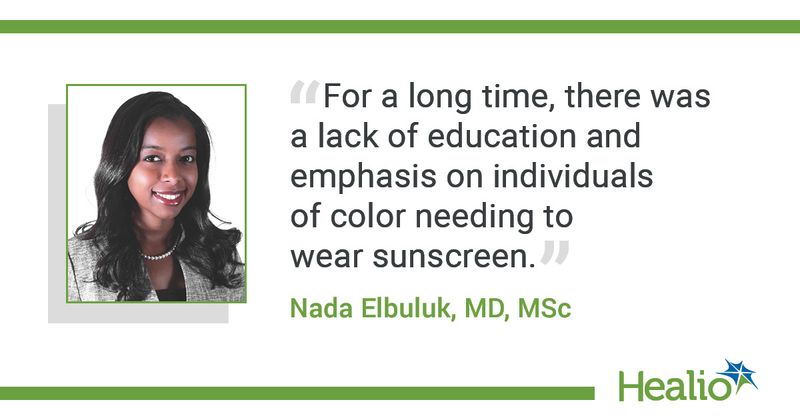Increase in Google searches for skin of color sunscreen signals need for patient education
Key takeaways:
- Relative search volume for the phrase “sunscreen for dark skin” increased by nearly 400% from 2006 to 2020.
- Relative search volume for “sunscreen for Black skin” increased 18-fold from 2008 to 2020.
Google searches about sunscreen use for patients with skin of color have quadrupled since 2006, giving dermatologists a prime opportunity to increase sunscreen education in this population, according to a study.
“For a long time, there was a lack of education and emphasis on individuals of color needing to wear sunscreen,” Nada Elbuluk, MD, MSc, associate professor of clinical dermatology at Keck School of Medicine at the University of Southern California, told Healio. “People with darker skin felt that sunscreen left a caste on their skin and they also felt that they didn’t need to use it.”

Elbuluk goes on to explain that many individuals with skin of color were unaware of the benefits of sunscreen for them due to misinformation and common misconceptions. However, this study has found that the paradigm is shifting.
Elbuluk and her colleague, Nicole C. Syder, BA, a medical student at Keck School of Medicine, hypothesized that the increase of education and the production of sunscreen for individuals with skin of color have helped create a rising interest regarding sunscreen use in darker skin. In this study, Elbuluk and Snyder set out to formally analyze this hypothesis.
The pair input “sunscreen for dark skin” and “sunscreen for black skin” into Google Trends to analyze the search trends of these phrases since 2004. They quantified their findings using relative search volume, a value that quantifies the absolute number of searches compared with the total number of searches over a given time period on a scale of 0 to 100 with 100 being the highest relative search volume.
Results showed that the annual relative search volume for “sunscreen for dark skin” began at approximately eight in 2006 and increased to 28 in 2020, reflecting a nearly 400% increase.
From 2006 to 2015, relative search volume remained between 0 and 30, with higher volumes observed in the months leading up to summer. However, in the summer of 2016, relative search volume rapidly increased and has followed an overall upward trend ever since, peaking in 2020.
The phrase “sunscreen for Black skin” ranged from 0.83 to 24.33 and also peaked in 2020, representing an 18-fold increase from 2008 to 2020. Specific phrases such as “best mineral sunscreen for dark skin,” “best sunscreen for Black skin,” “Black girl sunscreen” and more related phrases received a “breakout” designation signifying a greater than 5,000% increase in searches.
The states with the highest relative search volume for “sunscreen for dark skin” or “sunscreen for Black skin” included Maryland, Georgia, New Jersey, North Carolina, New York and California, with Maryland having a relative search volume of 100 for both phrases.
When asked why Google searches for this topic have increased, Elbuluk said it may be due to the increase of inclusivity in marketing, social media and company production.
“New formulations of sunscreen, which are more elegant, including in the mineral sunscreen category, have allowed people with darker skin to feel that they can wear sunscreen that looks good on their skin color,” Elbuluk said.
Additionally, Elbuluk credits the rise of interest to the increase of dialogue about the benefits of sunscreen from dermatologists, journalists, beauty editors and those working in public health. Benefits that include slowing down the signs of aging, preventing worsening of pigmentary disorders and decreasing the risk for skin cancers are not limited to white patients but affect people with skin of color too.
“This is a positive shift,” Elbuluk concluded, “that could be further supported by education from dermatologists, dermatology organizations and other people in the public health space to educate populations of color about not only the benefits of sunscreen but how to use it properly.”

